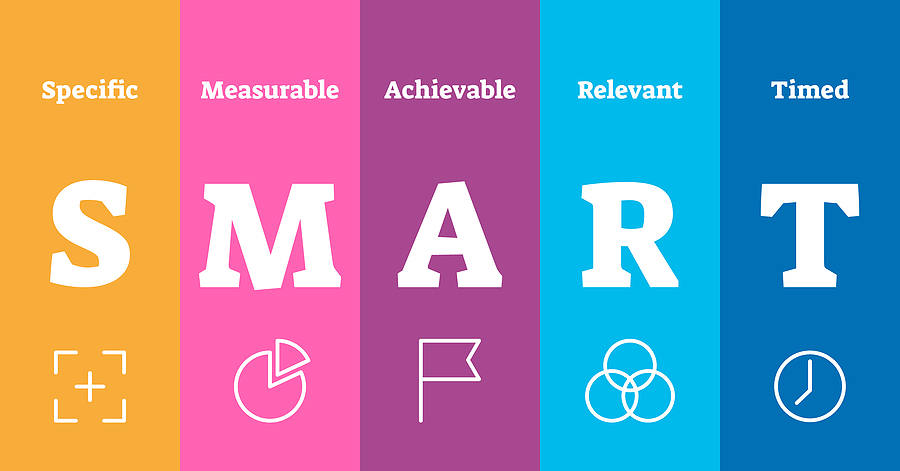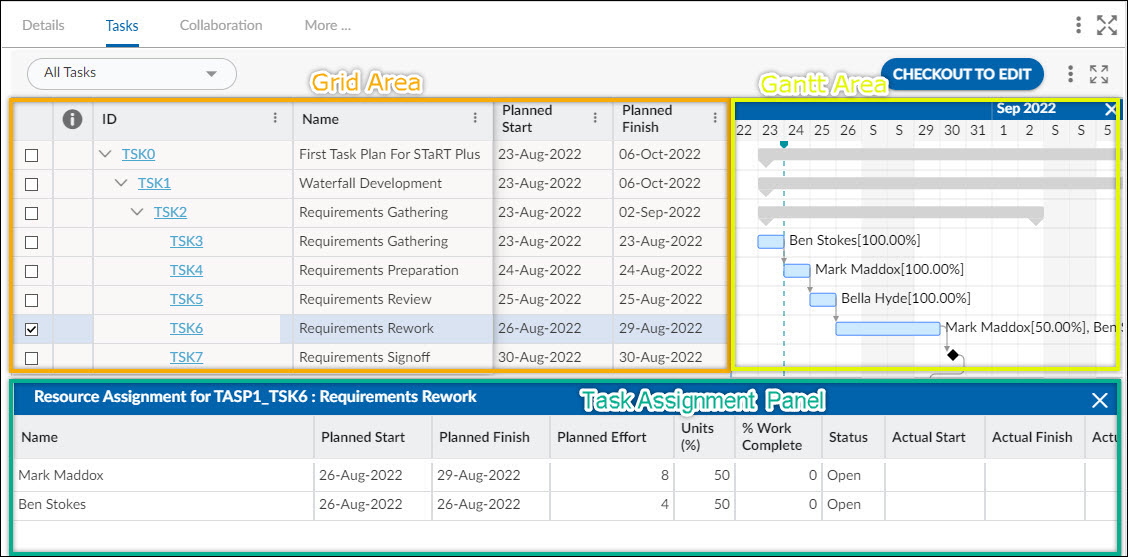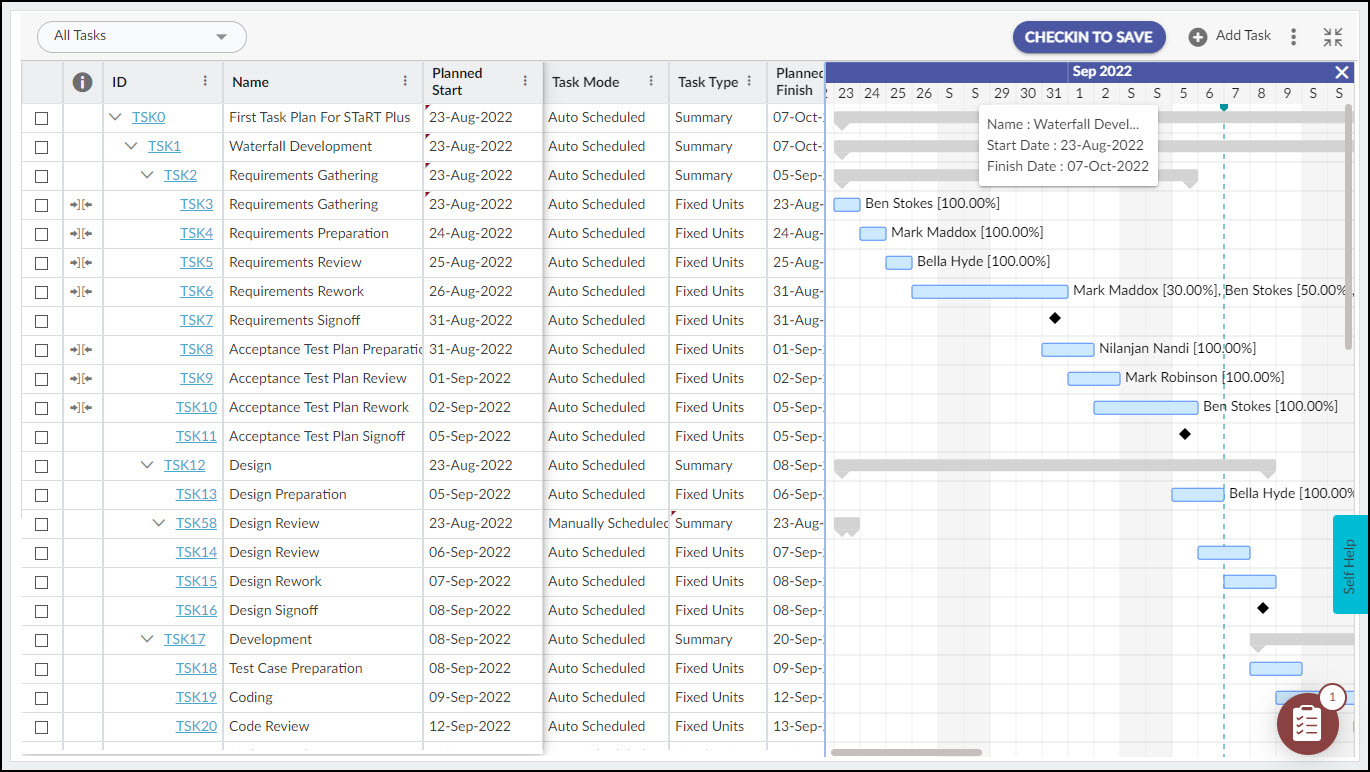The Essential Guide to Creating Effective Action Plans - (With Examples)
- 12 mins read
-
 By
Bravin Wasike
By
Bravin Wasike
- Updated on September 17, 2024
Overview
In project management and personal productivity, action plans are indispensable tools for outlining specific steps to achieve desired objectives. In professional settings or personal endeavors, action plans provide a structured approach to goal attainment, helping individuals and teams stay organized, focused, and accountable.
In this article, we will cover the concept of action plans. We will discuss their definition, components, practical uses, steps for creating action plans, and practices for effective implementation.

What is an Action Plan?
An action plan can be defined as a detailed document that outlines specific tasks, milestones, timelines, and responsibilities required to accomplish a particular goal or objective. It gives the general outline of the specific steps, tasks, and resources required to achieve a particular goal or objective.
It serves as a roadmap that guides individuals or teams through the process of executing tasks systematically to achieve desired outcomes. Unlike broader strategic plans, action plans are highly specific and actionable, focusing on the implementation phase rather than overarching strategies.
Components of an Action Plan
Effective action plans typically encompass the following key components:
1. Clear and Specific Goals
The foundation of any action plan is a clearly defined and specific goal. This overarching goal sets the direction for the entire plan. Avoid vague statements like “improve sales.” Instead, aim for SMART goals: Specific, Measurable, Achievable, Relevant, and Time-bound. For example, a SMART goal could be “Increase online sales by 20% within the next quarter.” A clear and specific goal provides a focused target for all subsequent steps within the action plan.
2. Detailed Tasks or Steps
Once the goal is defined, it’s time to break it down into detailed tasks or steps. These are the practical, actionable activities required to achieve the defined objectives. Each task should be clearly defined, outlining exactly what needs to be done. For instance, to achieve the goal of increasing online sales by 20%, some detailed tasks could include:
• Optimize product listings for search engines
• Develop targeted social media campaigns
• Offer limited-time discounts and promotions
• Create email marketing campaigns to promote new products
• Improve website user experience for a smoother buying process
3. Allocation of Resources
Effective action plans consider the resources needed to complete the tasks. This includes the allocation of team members, budget, and equipment.
• Team Members: Identify the people with the necessary skills and expertise to complete each task. Assign ownership of tasks to specific individuals or teams, ensuring accountability.
• Budget: Estimate the financial resources required for the action plan. This might include costs associated with marketing campaigns, software subscriptions, or equipment rentals. Having a clear understanding of the budget helps ensure efficient resource allocation and avoids potential roadblocks due to financial constraints.
• Equipment: Identify any necessary equipment or tools required to complete the tasks. This could range from specialized software to physical equipment needed for certain activities. Ensure the availability of all necessary resources before commencing with the action plan.
4. Prioritization of Tasks
Not all tasks are created equal. Some tasks are more critical to achieving the overall goal than others. Prioritization of tasks ensures that the most important tasks are completed first, maximizing efficiency and progress. Prioritization techniques like the Eisenhower Matrix can be helpful in categorizing tasks based on urgency and importance. Nimble’s task prioritization features allow you to easily organize and focus on the most crucial tasks, ensuring your projects stay on track and aligned with your goals.
5. Monitoring and Revision Mechanisms
Action plans are not static documents. It’s crucial to establish monitoring and revision mechanisms. Regularly track progress against the defined timeline and objectives. Evaluate the effectiveness of the tasks and resource allocation.
If there are deviations from the plan or unforeseen challenges arise, be prepared to adapt and revise the action plan accordingly. This might involve adjusting tasks, deadlines, or resource allocation to ensure the plan remains on track for achieving the overall goal.
What is the Purpose of an Action Plan?
Action plans serve a multitude of purposes, making them essential tools for achieving success in any endeavor. It guides you through each crucial step required to achieve the desired outcome.
Source; Slidemodel.com
The following are some of the key benefits of utilizing action plans:
1. Improved Organization and Clarity: Action plans provide a clear framework for breaking down complex goals into manageable tasks. This fosters improved organization and clarity, ensuring everyone involved understands the overall objective and their specific role in achieving it.
2. Enhanced Efficiency and Productivity: Action plans streamline workflows and optimize resource allocation, leading to increased efficiency and productivity. Action plans help eliminate wasted time and effort by prioritizing tasks and ensuring everyone is working on the most impactful activities.
3. Prioritization and Time Management: The process of creating an action plan necessitates prioritizing tasks and setting realistic deadlines. This fosters effective time management. With clear priorities and deadlines outlined, individuals and teams can allocate their time strategically, maximizing their output and ensuring the timely completion of the project.
4. Boosted Accountability and Ownership: Assigning ownership of tasks within the action plan promotes accountability and fosters a sense of ownership among team members or individuals. Knowing they are responsible for specific deliverables within the plan motivates individuals to take ownership of their work and strive for excellence.
5. Improved Communication and Collaboration: When working collaboratively on a project, action plans ensure clear communication and collaboration among team members. The plan outlines the overall goal, individual tasks, and deadlines, fostering transparency and keeping everyone aligned. This improved communication minimizes misunderstandings and ensures everyone is working towards the same objective.
6. Risk Management and Mitigation: Action plans are not just about outlining tasks; they also play a crucial role in risk management and mitigation. The process of creating an action plan often involves identifying potential risks and obstacles that could hinder progress.
7. Flexibility and Adaptability: The world doesn’t always operate according to plan. Action plans, however, are not static documents. They can be adjusted and modified as circumstances change, ensuring flexibility and adaptability. If unforeseen challenges arise or opportunities present themselves, the action plan can be revised to reflect the new reality, ensuring the project stays on track for success.
8. Motivation and Morale: Seeing tangible progress towards the goal through a well-defined action plan can be a significant motivator for individuals and teams. Action plans break down the journey into achievable milestones, allowing for recognition and celebration of accomplishments along the way. This positive reinforcement helps maintain motivation and morale, propelling individuals and teams towards achieving the final objective.
Types of Action Plans
There are many types of action plans to fit various needs. The following are some common ones:
☑ Business Action Plan: A long-term roadmap for an entire organization’s goals, including market analysis, financial projections, marketing strategies, and operational plans.
☑ Marketing Action Plan: Focused on promoting a product or service, it outlines strategies to achieve marketing goals within a timeframe. This includes target audience, marketing mix, channels, and budget allocation.
☑ Corrective Action Plan: Implemented when problems arise, it focuses on identifying the root cause, corrective measures, and preventing future occurrences.
☑ Sales Action Plan: Designed to boost sales, it outlines activities and strategies to achieve sales goals. This includes the target market, sales strategies, process optimization, and performance tracking.
☑ Project Action Plan: Focused on completing a specific project, it outlines steps required to deliver a defined outcome. This includes project scope, task breakdown, resource allocation, timeline, and risk management.
☑ Operational Action Plan: Streamlines day-to-day operations, focusing on standard procedures, performance metrics, and process improvement.
☑ Personal Development Action Plan: Empowers individuals to take charge of personal growth, translating goals into steps across various aspects of life.
Action Plan Examples
1. Marketing Campaign Launch
Imagine launching a marketing campaign to promote a new product. An action plan for this scenario might include the following:
Goals and Objectives
• Increase brand awareness for the new product by 20% within the next quarter.
• Generate 1,000 qualified leads within the first month of the campaign.
• Increase website traffic by 15% during the campaign period.
Tasks and Activities
• Develop a compelling product launch message and professional branding strategy.
• Design and build a dedicated landing page for the new product.
• Create engaging social media content to promote the product launch.
• Develop email marketing campaigns targeting potential customers.
• Secure media placements for product reviews and promotion.
• Implement a paid advertising campaign across relevant platforms.
• Track website traffic, lead generation, and brand mentions.
Resources
• Marketing team members with expertise in content creation, social media marketing, and email marketing.
• Graphic designer for creating visuals and landing page design.
• Budget allocation for paid advertising campaigns.
• Project management tools for tracking tasks and progress.
Timeline and Deadlines
• Finalize product launch messaging and branding (2 weeks before launch)
• Develop landing page and marketing materials (3 weeks before launch)
• Launch social media campaign (1 week before launch)
• Initiate email marketing campaign (on launch day)
• Monitor campaign performance and adjust strategies as needed (throughout the campaign)
2. Website Redesign Project
Planning a website redesign requires careful consideration. An action plan for this project could include:
Goal: Revamp the company website to improve user experience (UX) and increase website conversions.
Objectives
• Reduce website bounce rate by 10%.
• Increase average time spent on the website by 15%.
• Increase online sales conversions by 5%.
Tasks and Activities
• Conduct user research to identify website usability issues and user needs.
• Develop a new website information architecture (IA) for optimal user navigation.
• Design a visually appealing and user-friendly website interface (UI).
• Develop content that is informative, engaging, and optimized for search engines (SEO).
• Implement website analytics tools to track user behavior and website performance.
Resources
• Web developer with experience in website design and development.
• User experience (UX) designer to focus on user experience optimization.
• Content writer to create engaging and informative website content.
• Budget allocation for website development and content creation.
Timeline and Deadlines
• Complete user research and define website requirements (2 weeks)
• Develop website IA and UI design (4 weeks)
• Develop website content (3 weeks)
• Implement website and launch (2 weeks)
• Monitor website traffic and user behavior after launch (ongoing).
3. Personal Development
Goal: Learn a new language (Spanish) and achieve conversational fluency within 6 months.
Objectives
• Complete a beginner’s Spanish language course by the end of month 2.
• Practice speaking Spanish for at least 30 minutes daily by month 4.
• Achieve a score of above 70% on a basic Spanish proficiency test by month 6.
Tasks and Activities
• Enroll in a beginner’s Spanish language course (online or in-person).
• Download a language learning app for daily practice exercises.
• Schedule daily practice sessions to learn new vocabulary and grammar.
• Find a language exchange partner for conversation practice (online or in-person).
• Immerse yourself in Spanish media like movies, music, and podcasts.
Resources
• Online language learning course or tutor.
• Language learning app subscription.
• Spanish-English dictionary and grammar resources.
• The time commitment for daily practice sessions.
Timeline and Deadlines
• Enroll in a language course and start learning (Week 1)
• Practice daily for at least 30 minutes using various methods (ongoing)
• Schedule language exchange sessions at least twice a week (month 3 onwards)
• Take a basic Spanish proficiency test by month 6
4. Event Planning
Goal: Organize a successful fundraising charity gala for a local animal shelter.
Objectives
• Secure a venue and catering services by 3 months before the event.
• Sell at least 150 tickets to the gala 1 month before the event.
• Raise a minimum of $10,000 in donations during the gala.
Tasks and Activities
• Identify a suitable venue with catering options that align with the budget.
• Design and distribute marketing materials to promote the event.
• Secure sponsorships and donations from local businesses.
• Plan the event program including entertainment, auctions, and activities.
• Coordinate logistics for volunteers, vendors, and equipment.
Resources:
• Event planning team with volunteers for various tasks.
• Budget for venue rental, catering, marketing materials, and entertainment.
• Fundraising platform for online ticket sales and donations.
Timeline and Deadlines:
• Finalize event date, venue, and catering (3 months before)
• Launch marketing campaign for ticket sales and sponsorship opportunities (2 months before)
• Finalize event program and confirm entertainment bookings (1 month before)
• Delegate tasks and coordinate logistics with volunteers (2 weeks before)
• Host the fundraising gala and track donations (event day)
The Process of Creating an Action Plan
Step 1: Set a SMART Goal
The foundation of any action plan is a SMART goal. SMART stands for:
☑ Specific: Clearly define what you want to achieve. Avoid ambiguity and ensure everyone involved understands the desired outcome.
☑ Measurable: Establish criteria to track your progress and determine success. How will you know you’ve achieved the goal?
☑ Attainable: Set a goal that is challenging yet achievable within your resources and capabilities.
☑ Relevant: Ensure the goal aligns with your overall objectives and priorities.
☑ Time-bound: Define a realistic timeframe for achieving the goal. When do you expect to reach the finish line?
Step 2: Identify Tasks
Once you have your SMART goal, it’s time to break it down into manageable tasks. These tasks represent the individual steps required to achieve your overall objective.
☑ Brainstorm: List all the activities and actions that come to mind as necessary to achieve the goal.
☑ Refine and Group: Review your list, eliminate redundancies, and group similar tasks together.
☑ Ensure Comprehensiveness: Verify that your tasks collectively cover all aspects needed to achieve the goal.
Step 3: Allocate Resources
Each task requires specific resources for successful completion. Resources can include:
☑ People: Identify the team members or individuals responsible for completing each task.
☑ Equipment and Materials: Determine any necessary tools, equipment, or materials required for each task.
☑ Budget: Estimate the financial resources required to complete the project, including personnel costs, materials, and any potential contingencies.
Step 4: Prioritize Tasks
Not all tasks are created equal. Some are more critical to the overall success of the project than others. Prioritization helps you determine the order in which tasks should be tackled.
☑ Impact: Prioritize tasks based on their significance to achieving the goal. Tasks with a higher impact on the overall outcome should be completed first.
☑ Dependencies: Consider any task dependencies. If one task relies on the completion of another, prioritize accordingly.
☑ Time Sensitivity: Certain tasks may be time-sensitive and require immediate attention. Factor in deadlines when prioritizing.
Step 5: Set Deadlines and Milestones
Deadlines establish specific timelines for completing each task. Milestones represent significant achievement markers along the way. Setting deadlines and milestones serves several purposes:
☑ Creates a sense of urgency: Deadlines motivate the timely completion of tasks.
☑ Tracks progress: Milestones help you measure progress and identify any potential delays.
☑ Improves accountability: Knowing deadlines and milestones keeps everyone accountable for their assigned tasks.
Step 6: Monitor and Revise Your Action Plan
The world doesn’t always operate according to plan. Even the most meticulously crafted plans may require adjustments as you progress. Monitoring involves regularly assessing your progress against your deadlines and milestones.
☑ Track progress: Monitor task completion, resource utilization, and project budget.
☑ Identify deviations: Be alert for any delays, roadblocks, or resource constraints.
☑ Adapt and revise: If necessary, revise deadlines, reallocate resources, or adjust your approach to ensure the project stays on track.
Overcoming Challenges in Action Plan Development
The road to achieving goals through action plans isn’t always smooth sailing. Here are some common challenges you might encounter during the development process, along with strategies to overcome them:
Challenge 1: Setting Unclear Goals
☑ Problem: Vague or poorly defined goals lack direction and make it difficult to develop actionable steps.
☑ Solution: Apply the SMART goal framework (Specific, Measurable, Achievable, Relevant, Time-bound) to ensure clarity and focus on your goals.
Challenge 2: Inadequate Task Breakdown
☑ Problem: Tasks that are too broad or not broken down into manageable steps can feel overwhelming and hinder progress.
☑ Solution: Employ brainstorming techniques to generate a comprehensive list of tasks. Then, refine and group these tasks based on complexity and dependencies. Ensure each task is clear, concise, and achievable within a reasonable timeframe.
Challenge 3: Unrealistic Resource Allocation
☑ Problem: Underestimating resource requirements or failing to consider resource availability can lead to delays and bottlenecks.
☑ Solution: Conduct a thorough resource assessment. Identify the people, equipment, materials, and budget required for each task. Be realistic about resource limitations and adjust your plan accordingly. Explore alternatives or seek additional resources if necessary.
Challenge 4: Lack of Prioritization
☑ Problem: Without prioritization, you risk tackling less critical tasks first, potentially jeopardizing the overall project timeline.
☑ Solution: Analyze the impact and dependencies of each task. Prioritize tasks based on their significance to achieving the goal and any upstream dependencies. Schedule high-impact tasks first and factor in time sensitivity when making prioritization decisions.
Challenge 5: Inflexible Deadlines and Milestones
☑ Problem: Rigid deadlines and milestones can create undue pressure and hinder your ability to adapt to unforeseen circumstances.
☑ Solution: Set realistic deadlines with buffer time to account for potential delays. Establish achievable milestones that celebrate progress and motivate the team. Be prepared to revise deadlines and milestones as needed based on the project’s evolving reality.
Conclusion
Action plans are the cornerstones of successful endeavors. They bridge the gap between aspirations and achievements, transforming goals into actionable roadmaps.
Remember, creating an action plan is an iterative process. Don’t be afraid to revisit and revise your plan as your project unfolds. Embrace flexibility, open communication, and a willingness to learn and adapt. With a well-crafted action plan as your guide and a commitment to continuous improvement, you can navigate any project toward successful completion.
Ready to transform your project management approach? Nimble is the ultimate tool for creating and implementing action plans, helping you stay organized, focused, and accountable. Experience the benefits of streamlined workflows and efficient goal attainment. Start your journey with Nimble today and see the difference it can make for your projects, take free trial
Share the Knowledge
About Author:

Bravin Wasike
Simplifying Project Management!
Explore Nimble! Take a FREE 30 Day Trial
PM 101
Work Packages 101: Simplifying Complex Projects for Better Management
Learn what work packages are in project management, how they improve project structure, and best practices for effective execution.
Marketing Metrics KPIs: The Ultimate Guide to Measuring Success
Unlock the power of marketing metrics and KPIs with this ultimate guide. Learn how to track, analyze, and optimize your campaigns for measurable success.
What is Digital Marketing? And Why is it Important for a Business?
Learn what digital marketing is and why it’s essential for businesses. Explore key strategies, benefits, and how it helps brands grow in the digital age.
How to Create a Digital Marketing Plan & Execute it with Nimble?
Learn how to create a digital marketing plan and execute it efficiently with Nimble. Discover strategies, tools, and best practices to drive marketing success.
How to Plan and Track Digital Marketing Campaigns?
Learn how to plan and track digital marketing campaigns effectively with key strategies, tools, and tips to ensure successful execution and measurable results.
Top 10 Tips for Social Media Management in 2025
Discover the top 10 tips for mastering social media management, including strategies for engagement, content creation, and staying ahead of evolving trends.
What is a Contingency Plan? 5 Steps to Create One
Learn what a contingency plan is and follow five key steps to create one for your project. Ensure your team is prepared to handle unexpected challenges and minimize risks.
What is a RACI Chart? A Complete Guide for Project Managers
Learn what a RACI chart is, how it clarifies roles and responsibilities in project management, and how to create one for your team to improve collaboration and accountability.








